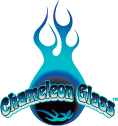Pyrex aint Pyrex anymore
Pyrex aint Pyrex anymore
If you have ever asked a glass pipe maker what raw materials they use to make a glass pipe, most will respond with the compound name of the type of silicate we use; Borosilicate. Back in the day, Pyrex meant Borosilicate….but, Pyrex aint Pyrex anymore. We no longer refer to it as Pyrex, because Pyrex is a brand name. A brand that is now manufactured in China, who, in an ongoing and well documented pattern, have completely cheapened the actual physical product, but continue to use the brand name Pyrex to fool the average American consumer into thinking they are getting the product that used to be synonymous with strength.
Today, the Pyrex you buy at cheap shlockhouse stores is generic soda-lime silicate with an added tempering step, made in China. Soda Lime silicate is the most common form of glass that we come into contact with daily in the form of bottles and packaging. Heat treating, or ‘tempering’ the glass does make it stronger, but it is nowhere near as strong as Borosilicate.
Why would they do that? Simple: You can’t visually see the difference. What you cannot see is Borosilicate is 10X more expensive to make, it is 50x more expensive to work into a usable product due to its higher melting point, and since it is far weaker than borosilicate, soda lime silicate is more prone to break, which means you have to buy replacements more often. The picture below is from Popular Science. It shows just how fragile Pyrex brand glass has become by putting a few drops of microwaved hot water into a soda lime silicate Pyrex brand measuring cup.

I have two points to make on this blog:
- The fact that many glass pipes coming from China are NOT made of borosilicate even though….
- More than 90% of the global supply of borosilicate is now made in China.
Grav Labs recently admitted to manufacturing their pipes in China. Many of us that were getting beaten up by their pricing suspected Grav Labs was importing glass pipes from China. I purchased a Grav Labs bong from a local store to perform some simple tests. The first test was to check the level of annealing. Annealing and tempering are similar because they use heat, but that is where the similarity ends. Annealing is at a distinctly higher temperature and takes far longer than tempering. Annealing is therefore a much more expensive process; which is why Chinese manufacturers routinely skip it…you the consumer can’t see it, so why should they spend the money on something you can’t see? But, aided with a common, inexpensive tool called a Polariscope, I can. The Grav Labs bong I inspected was riddled with residual stress as it clearly had not been annealed, leaving it prone to breaking. Frankly, I expected that. What I did NOT expect followed.
A Polariscope is a common and easy tool to inspect glass. Not as commonly known is that vegetable oil has the same refractive index as borosilicate. Without going into a bunch of physics about the speed of light through materials, I will tell you this: True borosilicate (clear) virtually disappears in vegetable oil because it has the same refraction index as the oil. When I dunked the Chinese made Grav piece in the oil….it did NOT disappear. It did not disappear because it was manufactured with soda lime silicate, just like all Pyrex brand glass made in China.
When you buy a pipe made in China, the greatest probability is that it is manufactured with cheap, un-annealed soda lime silicate, mainly because it’s way cheaper and you can’t visually see the difference….until it breaks. NONE of the American Made pipe companies I am aware of cheat their consumers by using soda lime silicate in place of borosilicate. For pipe buyers, my advice is this: without a Made in USA sticker, it’s Chinese or Indian glass. If you’re buying a cheap ass throw away at the local quickie mart, who cares. If you’re throwing down some serious coin on a piece you’re planning to keep for a while….well, make sure it’s borosilicate by demanding a model made in USA.
Interestingly enough, the European equivalent to Pyrex brand (Duran Glass) is actually still borosilicate, even though the finished goods are predominantly made in China, like most borosilicate is. So, the only reason that Chinese made pipes are NOT made of boro is that soda lime glass is a lot cheaper and you can’t tell the difference until it breaks.
I find some unfortunate humor in all of this. Corporate types project American values and culture on their chinese manufacturers and then assume everything is hunky dory. I’m sure Grav Labs would claim they had no idea that China had substituted soda lime silicate for borosilicate, just like parent company Teavana said in a statement about a product recall as recent as 2015. Teavana tea making carafe prone to explode ahhhh yes, that awesome chinese quality. But that’s just limited to no-name companies that cannot exert control on their chinese suppliers, right? Oops. Starbucks recalls tea pitchers from China
I also find humor in the social media trolls who lampoon legit American companies with false accusations of being “Chinese”. When pressed to explain, they back off and give some lame excuse about the raw borosilicate that is used being made in China. Very few other places than China make boro anymore, mainly because China uses predatory pricing to eliminate local industry. For decades, there was no production volume borosilicate made in the US. To get boro NOT made in China, you had to source from Kavalier/Simax in the Czech Republic, and then, they only made clear boro. Frankly, we were forced to use Chinese made boro, there just wasn’t anything else left to buy after Corning shuttered Parkersburg. Trolls either don’t know their glass history or choose to ignore it because they have an ax to grind.
Until only very recently has a production volume clear boro plant existed on US soil; Nipro in New Jersey. Many American pipe makers like Chameleon Glass now source raw material from Nipro. We also use Schott “Boro-artistic’ brand glass which is the generic brand of ‘Duran’ Glass tubing that is manufactured in the Czech Republic, not China. Larger scale production requires a ready supply of raw materials, which is now available from non-chinese sources.
Chameleon raw materials stock:

Note the Nipro label to the left of the Fragile sticker on this 3000 pound pallet of Made in USA 26×4 boro

Case after case after case of Schott manufactured Boro Artistic brand Duran Glass line the walls
The exception to that is colored boro tubing. Yes, there are hand pulled tubes of specialty, exotic and expensive colors like Illuminati, Purple Rain and Green Slyme from boutique producers like Northstar, Glass Alchemy and Trautman Art Glass. Unfortunately, the demand for these unique colors in hand pulled tubing far outstrips the supply. By nature; hand pulled vs. machine extruded, this relegates that artisan tubing to the realm of the high end glassblower who makes one or two pies a week and can charge $500 or more per pipe.
In the land of production where Chameleon and most pipe makers dwell, colored production tubing comes from one place for the foreseeable future, whether we like it or not. Do we have to use it? No. I could eliminate all production pipes that use colored tubing from China. I could also eliminate those jobs too, because the colored tubing from China is used throughout the US glass pipe industry and any number of competitive pipe makers here in the US would love to pick up the business. Still, I wish it were not so, and I look forward to finding a non-chinese source for the colored tube. I already happily pay more for non-chinese clear boro, and would continue that practice if non-chinese colored boro was available in production volume.



Leave a Reply
You must be logged in to post a comment.